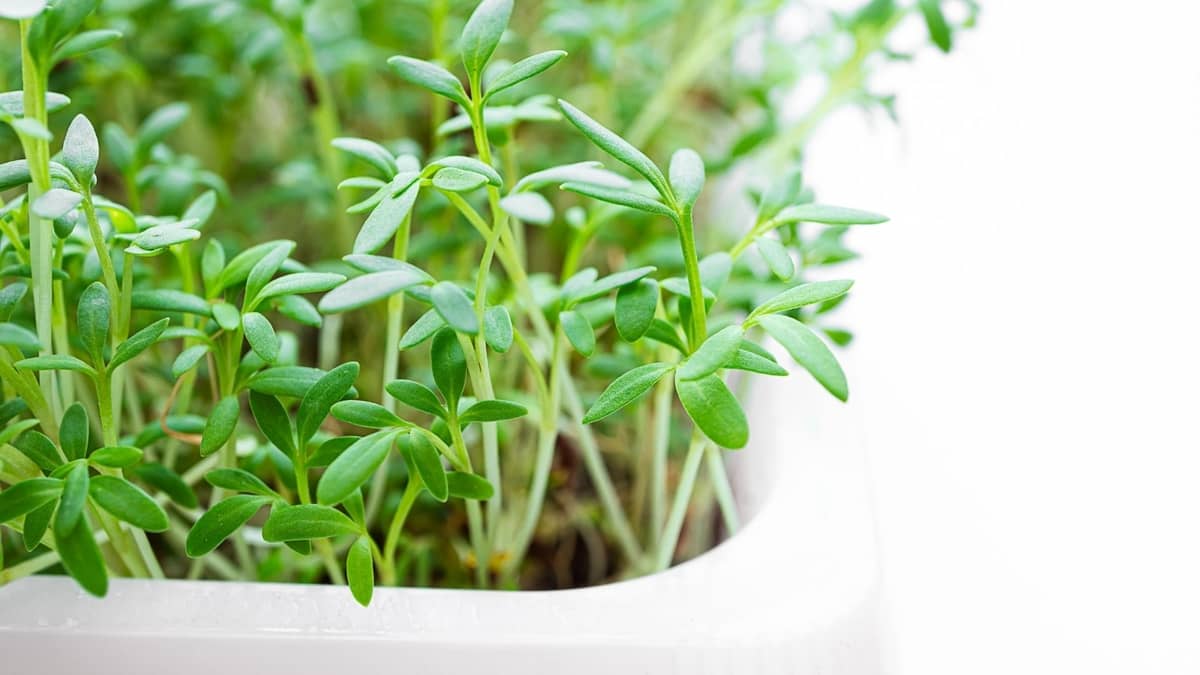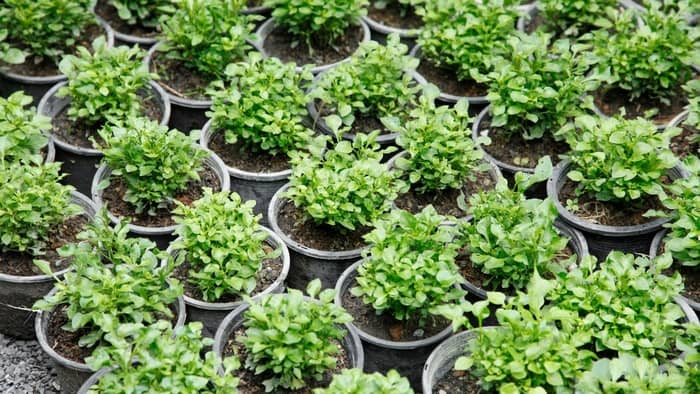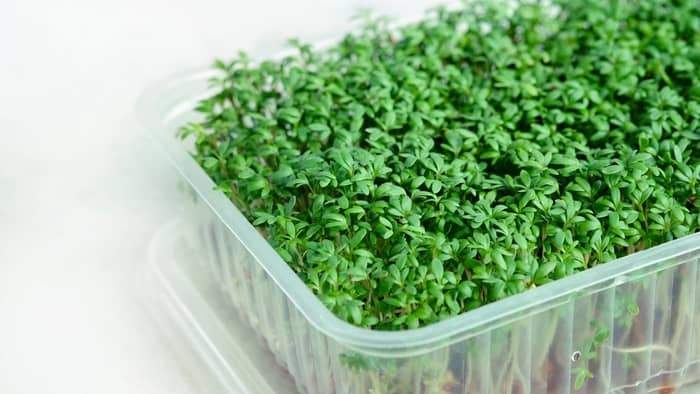Last Updated on February 14, 2022 by Guillermina
Wondering can you grow watercress indoors? Click and learn how to grow this hardy & nutrient-dense vegetable inside your living room.
Did you know that watercress was a staple food in the diet of Roman soldiers?
Although once considered a weed, watercress was first cultivated in the UK in the early 1800s and has since been grown on watery beds around the world.
Watercress is one of the most nutritious greens you can find. They are great for growing outdoors in the shade, but many often wonder can you grow watercress indoors? Therefore, keep reading to find out the answers to all the questions that might interest you.
Watercress – Description & Benefits
Watercress – also known as yellowcress or garden cress (Nasturtium officinale) is a perennial aquatic plant that comes from the mustard family (Brassicaceae). He is also a member of the cruiser family, which includes kale, broccoli, and brussels sprouts.
Watercress originates from Eurasia and thrives best when grown in cold flowing streams, where it grows submerged, floating on water, or spread over muddy surfaces. In addition, watercress is often grown in containers, pots, or moist soil for its edible young shoots and delicate pepper-flavored leaves.
Adding this superfood to your diet will help the body fight various diseases, but also promote general health.
Here are some of the benefits of regular watercress consumption:
- It can reduce inflammation and the risk of chronic diseases.
- Watercress can be used as a prevention and treatment of cancer.
- It boosts immune levels.
- Watercress contains healthy minerals that help lower blood pressure.
- Strengthens bones and teeth.
- It helps treat diabetes.
- Beneficial for heart health.
Can You Grow Watercress Indoors?
Watercress grows naturally in gently running water forming dense mats. The locations it prefers are natural springs, bogs, streams, and river banks. So, if you’re looking to add one more herb to your windowsill collection you don’t need to go any further than this beauty. Keep reading to find out all about this plant.
Is Watercress Easy To Grow Indoors?
Since watercress crops up on its own in areas of slightly alkaline, it is quite easy to grow indoors and requires little maintenance.
Can You Grow Watercress In A Jar?
Unlike most other plants, the roots of watercress prefer to be waterlogged, which makes this plant ideal for growing in jars. In addition, as its name suggests, watercress grows on water.
Also, it is important to emphasize that some commercial growers opt to grow watercress in water-based systems to mimic their indigenous growing conditions. However, this is not recommended unless you have a system that continuously circulates fresh water through the root system.
When Should I Start Watercress Seeds Indoors?
When it comes to growing watercress indoors (or the right time to do so) – it can be grown and harvested year-round. However, the taste in the leaves is best during the colder months of the year. Also, the taste degrades if the indoor temperature rises above 85 ℉ or when the plant flowers.
What Is The Best Way To Grow Watercress?
Now that we have answered the question “can you grow watercress indoors” it is time to explain how to do it. Watercress can be grown in containers on your windowsill or patio all year round, it is only important to provide it with good growing conditions.
Read more about Growing Thai Chili Peppers Indoors – The Ultimate Guide To A Successful Harvest
Growing Conditions
Try to place it in a shady place as it prefers about four hours of sunlight early in the day. It is not a big fan of the hottest and most intense afternoon sun, in that period the watercress prefers to stay in the shade. Also, place the containers on a north-facing window or on a windowsill that gets shade from a nearby tree in the afternoon.
Watercress grows in nature in water environments that are naturally colder, therefore they thrive best when indoor temperatures are between 60 and 70 ℉. – Remember, heat affects the taste of leaves.
Growing Media
When it comes to growing watercress indoors and soil selection, it is not advisable to use soil for the garden. Watercress grows best in a soilless potting mix containing perlite or vermiculite, which is then mixed with peat to increase water retention. Also, to thrive indoors, keep the pH of the soilless potting mix between 6.5 and 7.5.
Containers
One of the key things you need to pay attention to is that the watercress is constantly filled with water. It is therefore recommended to create a dual-container system when you plant it.
Pick two containers slightly different in size (so that one fits into the other). Take a smaller one and drill holes in the bottom to enable it to soak in water. Then place a coffee filter or paper towel on the bottom to keep the growing media from rinsing through the holes. As for the larger container, it should not have holes and should always be filled with water.
Finally, when it comes to the material from which the container is made, plastic has an advantage over clay or terracotta pots since they tend to lose water through evaporation.
Watering
Watercress will not germinate without water; therefore you have to always pay attention to this aspect. The best option is to keep a few inches of water in a larger container at all times. It is also advisable to regularly add freshwater (every day or every other day) to prevent the water from becoming stagnant.
Fertilization
Watercress plants prefer light fertilization. It is recommended to use less than half of the recommended rate on the label from time to time. Simply mix the diluted solution in water and then add it to a larger container to be absorbed into the growing media.
In Conclusion
Watercress is a powerful vegetable that is rich in many important nutrients. Plus, it is a delicious addition to any meal (but also a nice change from the usual lettuce or spinach). This water-loving, cool-season crop is very easy to grow indoors, requires very little maintenance, and can be harvested all year round. What else can you expect from an indoor plant?
We hope you found this article on “Can you grow watercress indoors” useful. What are your experiences with this plant? Let us know in the comments.
You may also be interested in How Fast Does An Oak Tree Grow Per Year?
FAQs
Is Watercress Easy To Grow Indoors?
Since watercress crops up on its own in areas of slightly alkaline, it is quite easy to grow indoors and requires little maintenance.
Can You Grow Watercress In A Jar?
Unlike most other plants, the roots of watercress prefer to be waterlogged, which makes this plant ideal for growing in jars. In addition, as its name suggests, watercress grows on water.
Also, it is important to emphasize that some commercial growers opt to grow watercress in water-based systems to mimic their indigenous growing conditions. However, this is not recommended unless you have a system that continuously circulates fresh water through the root system.
When Should I Start Watercress Seeds Indoors?
When it comes to growing watercress indoors (or the right time to do so) - it can be grown and harvested year-round. However, the taste in the leaves is best during the colder months of the year. Also, the taste degrades if the indoor temperature rises above 85 ℉ or when the plant flowers.
What Is The Best Way To Grow Watercress?
Growing Conditions
Try to place it in a shady place as it prefers about four hours of sunlight early in the day. It is not a big fan of the hottest and most intense afternoon sun, in that period the watercress prefers to stay in the shade. Also, place the containers on a north-facing window or on a windowsill that gets shade from a nearby tree in the afternoon.
Watercress grows in nature in water environments that are naturally colder, therefore they thrive best when indoor temperatures are between 60 and 70 ℉. - Remember, heat affects the taste of leaves.
Growing Media
When it comes to growing watercress indoors and soil selection, it is not advisable to use soil for the garden. Watercress grows best in a soilless potting mix containing perlite or vermiculite, which is then mixed with peat to increase water retention. Also, to thrive indoors, keep the pH of the soilless potting mix between 6.5 and 7.5.
Containers
One of the key things you need to pay attention to is that the watercress is constantly filled with water. It is therefore recommended to create a dual-container system when you plant it.
Pick two containers slightly different in size (so that one fits into the other). Take a smaller one and drill holes in the bottom to enable it to soak in water. Then place a coffee filter or paper towel on the bottom to keep the growing media from rinsing through the holes. As for the larger container, it should not have holes and should always be filled with water.
Finally, when it comes to the material from which the container is made, plastic has an advantage over clay or terracotta pots since they tend to lose water through evaporation.
Watering
Watercress will not germinate without water; therefore you have to always pay attention to this aspect. The best option is to keep a few inches of water in a larger container at all times. It is also advisable to regularly add fresh water (every day or every other day) to prevent the water from becoming stagnant.
Fertilization
Watercress plants prefer light fertilization. It is recommended to use less than half of the recommended rate on the label from time to time. Simply mix the diluted solution in water and then add it to a larger container to be absorbed into the growing media.





